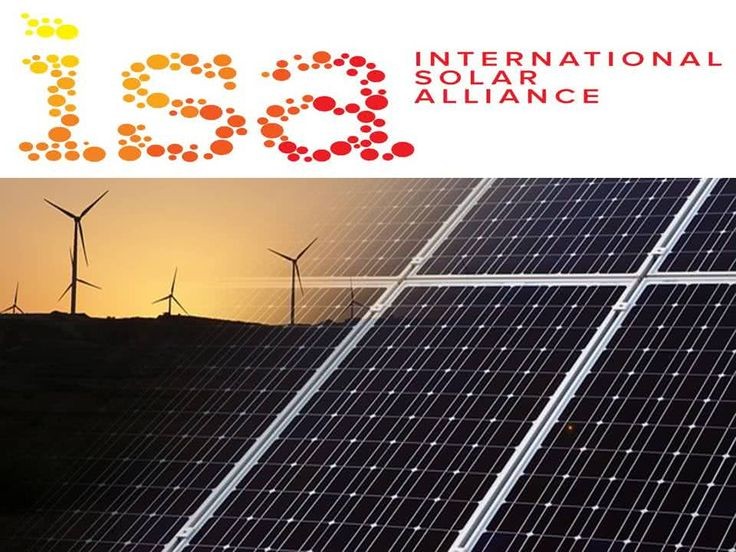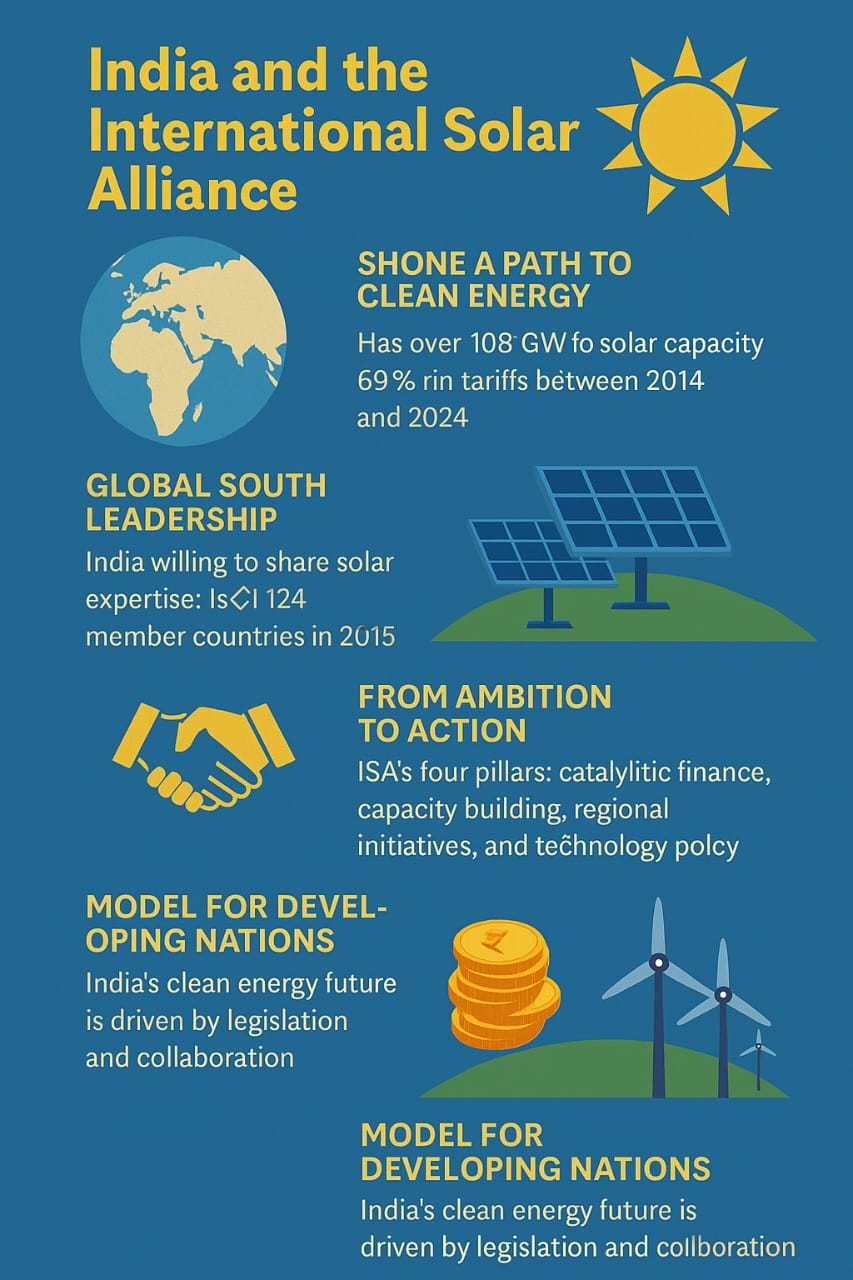Table of Contents
In the 21st century, the energy discourse has transitioned from reliance on fossil fuels to the pursuit of renewable autonomy, propelled by climate urgency, economic evolution, and technological advancement. India, as a developing nation with increasing energy requirements, has established itself not just as a player but as a leader in the global solar revolution. This leadership is both emblematic and systemic, grounded in international diplomacy, domestic policy transformations, and institutional frameworks such as the International Solar Alliance (ISA).
Genesis of the International Solar Alliance (ISA)
- The International Solar Alliance (ISA) was inaugurated in 2015 during COP-21 in Paris as a collaborative initiative between India and France, aimed at mobilising solar-abundant nations situated between the Tropics of Cancer and Capricorn to collaboratively utilize solar energy for sustainable development.
- ISA refers to:
- The first intergovernmental treaty-based organisation was formed in India.
- Consisting of 124 member nations, primarily from the Global South.
- An acknowledged observer to the UNFCCC, vigorously promoting solar-driven transformations.
- The alliance anticipates a future where accessible solar energy may enhance energy security, reduce poverty, and promote climate justice, particularly for developing and small island states.

India’s Solar Surge: A Decade of Decisive Transformation
India’s solar trajectory has been influenced by:
- Robust regulatory systems under the stewardship of Prime Minister Narendra Modi.
- Organisations such as the Solar Energy Corporation of India (SECI) facilitate transparent auctions and prompt subsidy distribution.
- A tenfold augmentation in solar capacity from 2014 to 2024, already over 108 GW, with 105 GW contributed in the past decade.
Essential Statistics
- Solar energy constitutes one-third of the overall renewable capacity expansions in the Global South.
- Tariffs have decreased by 69%, enhancing the accessibility of solar energy, with ₹2.00 per kWh representing the lowest offer in 2024.
- Domestic production increased, with module capacity reaching 80 GW and cell capacity at 25 GW.
- This expansion represents not merely an economic achievement but also a paradigm of energy democratisation.
The Four Pillars of ISA: From Ambition to Action
ISA’s strategic vision, anticipating COP-30 (2025), centres on four transformative pil
1. Catalytic Finance Hub
- Mitigates the deficiency of capital accessibility in the Global South.
- Launched the Global Solar Facility, commencing with the Africa Solar Facility ($200 million).
- Utilises risk-mitigation instruments and blended financing to draw private investments.
- In Nigeria, junior equity support will provide electricity to over 10 million households.
2. Development of Capacity
- STAR-C: National Centres of Excellence in ten nations, anticipated to reach sixteen by 2025.
- Establishing a Global Capability Centre in collaboration with partners such as the EU, Denmark, and France.
- The SolarX Startup Challenge assists nascent businesses in Africa, India, Asia-Pacific, and is currently extending its reach to Latin America.
- A digital knowledge-sharing platform is under development.
3. National and Regional Participation
- Initiatives such as One Sun One World One Grid (OSOWOG) and Small Island Developing States (SIDS).
- Facilitates transcontinental grid connection and enhances storage efficiency.
- Implementation support at the ground level through the Multi-Donor Trust Fund.
4. Technological Roadmaps and Policies
- Recommendations for national solar strategy, prioritisation of technologies, and policy improvements.
- Encompasses green hydrogen, supply chain evaluations, and battery/photovoltaic waste management.
- Promotes sustainable and circular solar ecosystems.

Environmental Law and India’s Renewable Commitment
Notable advancements in environmental legislation accompany India’s emergence as a solar giant.
Constitutional Mandates
- Article 21: The right to life encompasses the right to a clean and sustainable environment, as established in Subhash Kumar v. State of Bihar.
- Article 48-A: Mandate to the State for environmental protection.
- Article 51-A(g): Obligation of citizens to safeguard the environment.
Legislative Framework
- Environment Protection Act of 1986
- Energy Conservation Act of 2001
- The National Action Plan on Climate Change (NAPCC) has eight missions, one of which is the National Solar Mission. The National Solar Mission is a significant project by the Government of India and State Governments aimed at fostering ecologically sustainable development while tackling India’s energy security issues. This will represent a significant contribution by India to the global endeavour to address the issues of climate change. The National Solar Mission aims to position India as a global leader in solar energy by rapidly establishing the necessary regulatory framework for its widespread adoption throughout the country.
- Green Hydrogen Policy (2022) and Battery Waste Management Regulations (2022).
Judicial Interventions
M.C. Mehta v. Union of India (Citation: AIR 1987 Supreme Court 1086)
This pivotal ruling broadened Article 21 (Right to Life) to encompass the right to a clean and healthy environment. It established the groundwork for environmental jurisprudence in India. The Court underscored the significance of the Precautionary Principle and Sustainable Development, both essential for India’s dedication to clean energy transitions such as solar adoption.
T.N. Godavarman Thirumulpad v. Union of India [ (1997) 2 Supreme Court Cases 267]
This continuing mandamus case reaffirmed the principle of intergenerational equity and the sustainable utilisation of natural resources. It reinforced the State’s obligation under Article 48A to safeguard the environment, bolstering India’s global position on climate-conscious measures, particularly solar energy initiatives.
Indian Council for Enviro-Legal Action v. Union of India [(1996) 3 Supreme Court Cases 212]
The Court held industries responsible for damage to the environment, instituting the polluter pays principle. This case reinforces ISA’s position on equitable and sustainable energy transitions, dissuading the use of polluting energy alternatives.
Hindustan Zinc Ltd. v. Rajasthan Electricity Regulatory Commission [(2015) 12 Supreme Court Cases 611]
The case concerned the renewable energy requirements (REOs) of corporations under the Electricity Act of 2003. The Court determined that the imposition of renewable energy purchase obligations was constitutional and consistent with national policy objectives. This ruling legally affirms India’s solar objectives and regulatory frameworks.
These instances highlight the judiciary’s active role in influencing India’s environmental governance, hence supporting ISA’s goals of advancing sustainable solar energy and advising other countries in the Global South.
ISA’s Global Significance in the Climate Conversation
1. Advocacy for the Global South
- ISA enhances energy equity, so that sunshine economies are not marginalised.
- India convened the Voice of Global South Summit (2024), featuring participation from 123 nations, to present its solar model.
2. Conformity with SDGs and the Paris Agreement, ISA is in alignment with:
- SDG 7: Affordable and clean energy
- SDG 13: Climate Action
- SDG 17: Global Partnerships
- Facilitates Nationally Determined Contribution (NDC) objectives under the Paris Climate Agreement through the promotion of technology transfer, climate financing, and sustainable infrastructure.
3. Addressing North-South Disparities
- ISA exemplifies Southern multilateralism in a domain traditionally governed by Northern institutions.
- India’s advocacy for Africa’s inclusion in the G20 reflects the ISA’s principle of equitable partnership, resonating with the “Vasudhaiva Kutumbakam” philosophy- One World, One Family.
Challenges and the Way Forward
Notwithstanding significant advancements, challenges remain:
- The storage infrastructure and battery recycling processes are currently inadequate.
- Land purchase and grid connectivity may impede solar adoption.
- The availability of a trained technical workforce is constrained in numerous member states.
- Financial flows continue to favour developed markets, neglecting high-irradiance yet economically disadvantaged countries.
Suggestions
- Decentralised solar systems, such as mini-grids in isolated regions.
- Enhance solar irrigation and rooftop initiatives.
- Establish technology transfer agreements and patent pooling arrangements.
- Establish climate justice funds with the backing of affluent nations.
- India’s solar narrative, guided by the International Solar Alliance, reconceptualises energy as a fundamental right- accessible, clean, and economical.
- The ISA provides a scalable and replicable framework to invigorate the Global South, transform climate geopolitics, and achieve energy justice through strategic foresight, legal support, and international cooperation.
- In an era of global instability, the ISA exemplifies collaborative federalism, technological advancement, and diplomatic prowess, reflecting India’s belief that “the sun does not set in the solar alliance.”


 Reserved vs General Quota: Supreme Court...
Reserved vs General Quota: Supreme Court...
 Supreme Court’s Interim Order on the W...
Supreme Court’s Interim Order on the W...



















